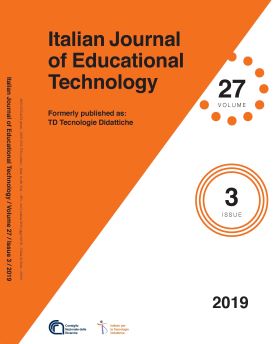INDICATORI PER IL RANKING DELLE UNIVERSITÀ ONLINE: LA PROSPETTIVA DEGLI STUDENTI
Contenuto principale dell'articolo
Abstract
Gli strumenti di ranking sono ampiamente utilizzati per valutare e confrontare le università, anche da futuri studenti. Tuttavia, gli attuali strumenti di ranking non valutano la dimensione online delle università, che ha visto una recente crescita. Al fine di superare questo limite, il progetto Europeo Creating an Online Dimension for University Rankings (CODUR) ha individuato criteri e indicatori per la dimensione online e ha chiesto a esperti di didattica online di valutarli. In questo articolo, le valutazioni degli esperti sono confrontate con quelle fornite da 55 studenti di università telematiche. Il confronto evidenzia che le prospettive di studenti ed esperti sono complessivamente simili, ma presentano alcune importanti differenze. In particolare, gli studenti accordano maggiore importanza alla qualità del supporto agli studenti e minore alla qualità dell’esperienza d’apprendimento. I risultati dello studio rappresentano un primo passo verso l’integrazione della prospettiva degli studenti nella dimensione online del ranking.
Dettagli dell'articolo
Gli autori che pubblicano su questa rivista accettano le seguenti condizioni:
- Gli autori mantengono i diritti sulla loro opera e cedono alla rivista il diritto di prima pubblicazione dell'opera, contemporaneamente licenziata sotto una Licenza Creative Commons CC BY 4.0 Attribution 4.0 International License.
- Gli autori possono aderire ad altri accordi di licenza non esclusiva per la distribuzione della versione dell'opera pubblicata (es. depositarla in un archivio istituzionale o pubblicarla in una monografia), a patto di indicare che la prima pubblicazione è avvenuta su questa rivista.
- Gli autori possono diffondere la loro opera online (es. in repository istituzionali o nel loro sito web) prima e durante il processo di submission, poiché può portare a scambi produttivi e aumentare le citazioni dell'opera pubblicata (Vedi The effect of Open Access).
Riferimenti bibliografici
Amsler, S. S., & Bolsmann, C. (2012). University ranking as social exclusion. British Journal of Sociology of Education, 33(2), 283-301. doi: 10.1080/01425692.2011.649835
Aversano, N., Manes-Rossi, F., & Tartaglia-Polcini, P. (2018). Performance measurement systems in universities: a critical review of the Italian system. In E. Borgonovi, E. Anessi-Pessina, C. Bianchi, (Eds.), Outcome-Based Performance Management in the Public Sector. System Dynamics for Performance Management, vol. 2. Cham, CH: Springer. doi: 10.1007/978-3-319-57018-1_14
Barron, G. R. (2017). The Berlin Principles on ranking higher education institutions: Limitations, legitimacy, and value conflict. Higher Education, 73(2), 317-333. doi: 10.1007/s10734-016-0022-z
Benjamini, Y., & Hochberg, Y. (1995). Controlling the false discovery rate: A practical and powerful approach to multiple testing. Journal of the Royal Statistical Society. Series B (Methodological), 57(1), 289-300. doi: 10.1111/j.2517-6161.1995.tb02031.x
Billaut, J. C., Bouyssou, D., & Vincke, P. (2009). Should you believe in the Shanghai ranking? An MCDM view. Scientometrics, 84(1), 237-263. doi: 10.1007/s11192-009-0115-x
Bonaccorsi, A., & Cicero, T. (2016). Nondeterministic ranking of university departments. Journal of Informetrics, 10(1), 224-237. doi: 10.1016/j.joi.2016.01.007
Bougnol, M. L., & Dulá, J. H. (2015). Technical pitfalls in university rankings. Higher Education, 69(5), 859-866. doi: 10.1007/s10734-014-9809-y
Bowden, R. (2000). Fantasy higher education: University and college league tables. Quality in Higher Education, 6(1), 41-60. doi: 10.1080/13538320050001063Q
Bowman, N. A., & Bastedo, M. N. (2011). Anchoring effects in world university rankings: Exploring biases in reputation scores. Higher Education, 61(4), 431-444. doi: 10.1007/s10734-010-9339-1
Brasher, A., Holmes, & Whitelock, D. (2017). A means for systemic comparisons of current online education quality assurance tools and systems. CODUR Intellectual Output IO1.A2. Retrieved from http://edulab.uoc.edu/wp-content/uploads/2018/06/CODUR-deliverable-IO1-A2.pdf
Çakır, M. P., Acartürk, C., Alaşehir, O., & Çilingir, C. (2015). A comparative analysis of global and national university ranking systems. Scientometrics, 103(3), 813-848. doi: 10.1007/s11192-015-1586-6
Cook-Sather, A. (2006). Sound, presence, and power: “Student voice” in educational research and reform. Curriculum Inquiry, 36(4), 359-390. doi: 10.1111/j.1467-873X.2006.00363.x
Cremonini, L., Westerheijden, D. F., Benneworth, P., & Dauncey, H. (2014). In the shadow of celebrity? World-class university policies and public value in higher education. Higher Education Policy, 27(3), 341-361. doi: 10.1057/hep.2013.33
Cremonini, L., Westerheijden, D., & Enders, J. (2008). Disseminating the right information to the right audience: Cultural determinants in the use (and misuse) of rankings. Higher Education, 55(3), 373–85. doi: 10.1007/s10734-007-9062-8
Ehlers, U.-D. (2006). Learners as active stakeholders of eLearning quality, EFQUEL Green paper Series. doi: 10.13140/RG.2.2.17720.14086
Ghislandi, P.M.M., & Raffaghelli, J. (2013). La voce degli studenti per la qualità dell’eLearning nella formazione universitaria: un approccio partecipativo. In V. Grion & A. Cook- Sather (Eds.), Joining the movement: bringing student voice to educational theory and practice in Italy (pp. 273–286). Milano, IT: Guerini & Associati.
Johnson, J. H. (1991). Student voice motivating students through empowerment (No. ED337875). Eugene, OR, USA: Oregon School Study Council.
King, B. (2012). Distance education and dual-mode universities: An Australian perspective. Open Learning: The Journal of Open, Distance and e-Learning, 27(1), 9-22. doi: 10.1080/02680513.2012.640781
Kroth, A., & Daniel, H. D. (2008). Internationale Hochschulrankings. Zeitschrift für Erziehungswissenschaft, 11(4), 542. doi: 10.1007/s11618-008-0052-0
Kurre, F. L., Ladd, L., Foster, M. F., Monahan, M. J., & Romano, D. (2012). The state of higher education in 2012. Contemporary Issues in Education Research (CIER), 5(4), 233-256. doi: 10.19030/cier.v5i4.7268
Li, K. C. (2018). The evolution of open learning: A review of the transition from pre-e-learning to the era of e-learning. Knowledge Management & E-Learning: An International Journal, 10(4), 408-425. doi: 10.34105/j.kmel.2018.10.025
Lynch, K. (2015). Control by numbers: New managerialism and ranking in higher education. Critical Studies in Education, 56(2), 190-207. doi: 10.1080/17508487.2014.949811
Marginson, S. (2007). The public/private divide in higher education: A global revision. Higher Education, 53(3), 307-333. doi: 10.1007/s10734-005-8230-y
McAleese, M., Bladh, A., Bode, C., Muehlfeit, J., Berger, V., & Petrin, T., ... Tsoukalis, L. (2013). Improving the quality of teaching and learning in Europe’s higher education institutions. High level group on the modernisation of higher education [Report to the European Commission] (p. 84). Luxembourg, LU: Publication Office of the European Union.
Pipitone, V., Fulantelli, G., & Allegra, M. (2004). Students perception on e-learning: a case-study. Academic Exchange Quarterly, 8(1), 261-267.
Pozzi, F., Manganello, F. Passarelli, M., & Persico, D. (2017). Develop test and refine representative performance online quality education indicators based on common criteria. CODUR Intellectual Output IO1.A3. Retrieved from http://edulab.uoc.edu/wp-content/uploads/2018/06/CODUR-deliverable-IO1-A3.pdf
Salmi, J., & Saroyan, A. (2007). League tables as policy instruments. Higher Education Management and Policy, 19(2), 1-38.doi: 10.1787/17269822
Schnelle, E. (1979). The MetaPlan method: Communication tools for planning and learning groups. Hamburg, DE: Quickborn.
Sponsler, B. (2009). The role and relevance of rankings in higher education policymaking. Washington, DC: Institute for Higher Education Policy.
Thurstone, L. L. (1927). A law of comparative judgment. Psychological Review, 34(4), 273. doi: 10.1037/h0070288
Turner, D. A. (2014). World class universities and international rankings. Ethics in Science and Environmental Politics, 13(2), 167-176.doi: 10.3354/esep00132
Usher, A., & Savino, M. (2006). A world of difference: A global survey of University league tables. Toronto, ON: Educational Policy Institute.
Van Dyke, N. (2005). Twenty years of university report cards. Higher Education in Europe, 30(2), 103-125. doi: 10.1080/03797720500260173
Vlăsceanu, L., Grünberg, L., & Pârlea, D. (2004). Quality assurance and accreditation: A glossary of basic terms and definitions. Bucharest, RO: Unesco-Cepes.

